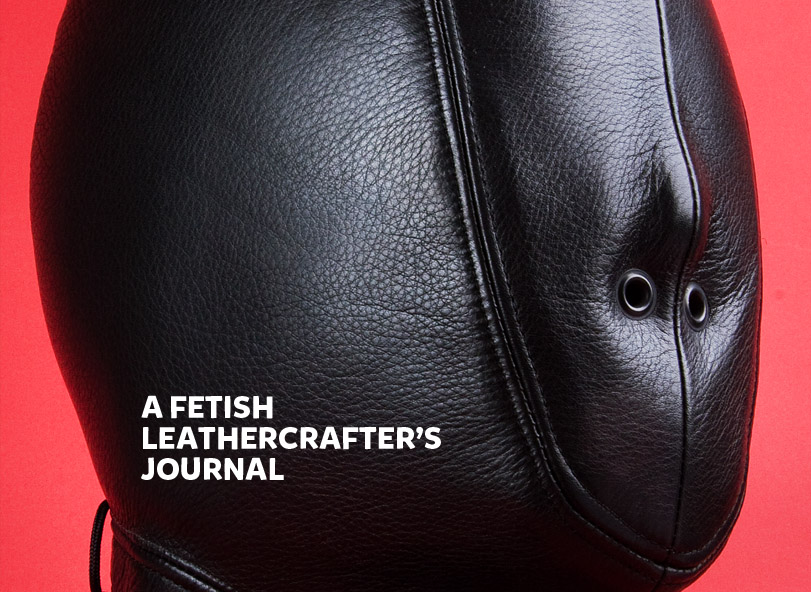I finished up a couple more molded head cases over the weekend, refined the process a bit and had some fun with the paint. Having completed the brown distressed version, I wanted to do one in a classic black, and one in a deep, rich blue - my model asked for me to match the color of the dress Lea Michelle wore to the Met Costume Institute Gala on one of them. It was a good challenge...
 For the black hood I used Fiebring's USMC black dye. It goes on with the leather slightly damp, and you can get a real deep rich black if you keep applying a lot of coats. I applied about 2 or 3 coats, and wiped down between each to keep some transparency and give the finish an aged look. I wanted it a bit antique looking, but subtle.
For the black hood I used Fiebring's USMC black dye. It goes on with the leather slightly damp, and you can get a real deep rich black if you keep applying a lot of coats. I applied about 2 or 3 coats, and wiped down between each to keep some transparency and give the finish an aged look. I wanted it a bit antique looking, but subtle. Once dry, I buffed the leather smooth with a brush and applied a light application of "bag coat" for a subtle sheen.
Once dry, I buffed the leather smooth with a brush and applied a light application of "bag coat" for a subtle sheen. I actually still need to glue down the seams, but am still toying with the idea of hand stitching the entire piece in a heavy tan thread.
I actually still need to glue down the seams, but am still toying with the idea of hand stitching the entire piece in a heavy tan thread. For the blue hood, I used Angelus brand water-based acrylic paint in sapphire. The photo doesn't really show the color accurately - it's actually a pretty dark blue.
For the blue hood, I used Angelus brand water-based acrylic paint in sapphire. The photo doesn't really show the color accurately - it's actually a pretty dark blue. I applied 2 coats of the color, then for the third coat I mixed in some "pewter" color - which has little silver metal flakes. It added sparkle without diluting the color, and gave the hood a deep, almost automotive finish.
I applied 2 coats of the color, then for the third coat I mixed in some "pewter" color - which has little silver metal flakes. It added sparkle without diluting the color, and gave the hood a deep, almost automotive finish. The acrylic paint dried with a pretty high level of gloss, and I didn't really need to add anything on top, although the instructions say you can add an acrylic finisher if you want a higher gloss or scuff protection.
The acrylic paint dried with a pretty high level of gloss, and I didn't really need to add anything on top, although the instructions say you can add an acrylic finisher if you want a higher gloss or scuff protection. These are very different from the hoods I normally make - they are so heavy and stiff they hold their shape all on their own. They're more like a gun holster or binocular case.
These are very different from the hoods I normally make - they are so heavy and stiff they hold their shape all on their own. They're more like a gun holster or binocular case. Based on the results I achieved with the paint, I am thinking of so many things I want to try with the vegetable-tanned leather. These experiments have been very inspiring, to say the least. I want to make about 50 of these, just so I can paint each one differently.
Based on the results I achieved with the paint, I am thinking of so many things I want to try with the vegetable-tanned leather. These experiments have been very inspiring, to say the least. I want to make about 50 of these, just so I can paint each one differently. On the first version below, I trimmed the seams after assembling the hood completely. But I think it is better to trim as the seams are sewn, and while the piece can be laid flat. It is much easier than trimming once the hood has been stretched on the form. Also, it is easier to cut the leather when it is wet from soaking.
On the first version below, I trimmed the seams after assembling the hood completely. But I think it is better to trim as the seams are sewn, and while the piece can be laid flat. It is much easier than trimming once the hood has been stretched on the form. Also, it is easier to cut the leather when it is wet from soaking. I don't know how practical these are to make for others, as the hood form is so specific, and I couldn't possibly carve one for each custom order. I don't even know how wearable they are, as I haven't even tried one on in my size. I suppose I should make one to find out...
I don't know how practical these are to make for others, as the hood form is so specific, and I couldn't possibly carve one for each custom order. I don't even know how wearable they are, as I haven't even tried one on in my size. I suppose I should make one to find out... Until next time...
Until next time...











































